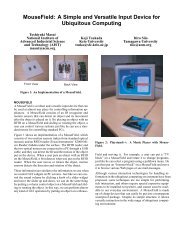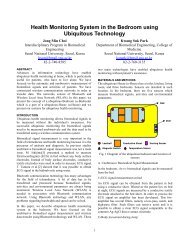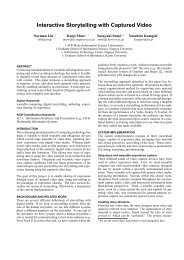Workshops - UbiComp
Workshops - UbiComp
Workshops - UbiComp
- No tags were found...
You also want an ePaper? Increase the reach of your titles
YUMPU automatically turns print PDFs into web optimized ePapers that Google loves.
Figure 2. Schematic picture of the actuatorsparts of the body (not necessarily encompassing all the sensorialorgans). An example would be a box with an aperturefor introducing a limb: when the user does so, he will experienceas if his arm or leg is in another environment, say,a space filled with water and sea creatures he can touch andfeel as real. Of course, one can argue that body propioception,vestibular sensation and visuospatial input are all basicsenses that a ‘total immersion interface’ should be able toreproduce, and that this is in direct contradiction with theidea of a partial interaction with the body. However, in certaincases this is an apparent limitation: compelling presencewithin the simulated environment may be effective with thissort of interface - even though not all the sensorial apparatusis engaged, in particular thanks to task-oriented (bottomdown)perceptual blindness [5]. Of course, there has beensome research on interfaces capitalizing on the limitationsof human attentional span or the physical limitations inherentto the visual organs (the best known being the foveal displays[5]). We are however interested in another issue: thatof an artificially generated sense of presence of a part of thebody within a virtual environment. Evidence for compellingpartial presence (i.e. partial body relocation) is describedin [6]. Lastly, a practical motivation for the proposed conceptis its compatibility with a wearable realization.TOTAL IMMERSIVE SYSTEMSA total immersive system needs to deal with at least twofundamental problems: the first is how to properly generateartificial sensory stimuli; the other is how to avoid the stimulifrom the real world to interfere with the simulation (i.e.achieving sensory deprivation). Futuristic brain-computerinterfaces may achieve both goals at once (c.f the ‘neuralplug’ in the movie the Matrix, described earlier by pioneeringwriter William Gibson in his 1984 novel Neuromancer).Present day more or less invasive BCI enable elementarymotor control [7] or generate sensations that would overlapwith the external world stimuli if these are present [8], [9].More conventional systems such as the CAVE [10] or HMDbasedVR systems may instead capitalize on real world stimuliin order to enhance the realism of the immersiveness, butthis is done at the expenses of the freedom of the simulation(i.e., one must constrain certain aspects of the simulatedworld such as the orientation on space, gravity and groundtexture). With respect to the CAVE, the HMD-based configurationenables a limited form of body sensory deprivation -Figure 3. redering of the virtual environmentperhaps by immersing the rest of the body in a liquid or makingthe user relax on a bed or chair. The latter approach hasbeen tried in an earlier experiment by one of the authors [11].The intent of the experiment was to create a realistic senseof presence in the virtual world (a WWI battlefield), whileat the same time cutting the subject from the real world sensoryinput. But can we imagine a system capable of totallyimmersing a part of his body in another world, while still capableof creating a (partial) sense of presence and sufficientemotional arousal?EARLIER WORK’Time Machine: VERDUN 1916’ [11] is an immersive systembuild by one of the authors that ‘sends’ users back intime at the site of Verdun (a battlefield during World WarI). The system achieves a high level of immersion thanks toa HMD and number of different actuators described in thefollowing (figure 2).A commercial stereoscopic HMD (the Z800 3DVisor fromeMagin with a diagonal FOV of approx. 40 deg) and inertialhead tracking was used to render the simulated environment(figure 3). Thanks to the information provided bythe inertial sensors, the user was able to look around whiletied on a modified dentist chair. The chair could tilt andvibrate as a whole (to simulate explosions) then providingsome form of vestibular stimulation, and was also coveredwith dozens of tactile actuators to simulate the ground texture(as the wounded avatar was being dragged on the floor).A belt covering the torso was fit with sixteen vibrators andwas used to render the footsteps of a rat walking over thelying body (figure 4).The HMD is fitted with noise cancelling ear bud speakers,but a pair of large isolating headphones seemed more efficientin reducing interferences from the real environment.Additional speakers and a subwoofer were used to renderlow frequency sounds produced by the shock waves of virtualexplosions. Since air flow can greatly enhance the feelingof presence on an open (virtual) space, a fan was installedto simulate wind as well as heat waves. Finally, an air-pump35






